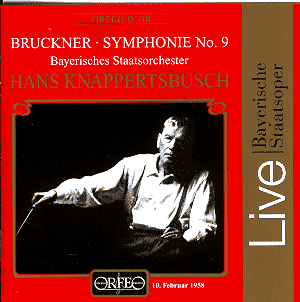It is one of the great ironies of our understanding of our
world that the further we move away from the time that events occurred,
the closer we can become to them, as the result of the accumulation of
research. This is absolutely true of music, as witness the trend towards
'authentic performance' which has been such a significant development.
Now Bruckner is a special case as far as authenticity
is concerned, and the various different performing editions of his scores
have their advocates. Some of the symphonies are more problematic than
others, but the great Ninth, the unfinished masterwork he dedicated
to his 'Dear God', is on the face of it more straightforward than its
fellows. This reissue of a live Hans Knappertsbusch performance from
1958 reminds us that the issue of editions exists also for this symphony.
It was only from the 1930s, long after Bruckner's death,
that the Ninth Symphony that he had composed began to establish itself
in the repertory. The first performance was posthumous, having taken
place in 1903, using the edition featured on this recording conducted
by Hans Knappertsbusch.
The fact that there was a first performance at all
owed much to Bruckner's disciple, the conductor Ferdinand Löwe,
who with the best intentions made his own performing edition of a score
which he felt to be incomplete beyond the fact of missing its final
movement. His changes largely consisted of re-scorings and small transitions,
and this version was performed on many occasions over many years. The
original only received its belated, posthumous premiere under Siegmund
von Hausegger, in Munich on 2nd April 1932. From that time onwards,
the growing interest in Bruckner's own editions (a complex matter of
course), led by the scholars Robert Haas and, later, Leopold Nowak,
helped to establish the original version as the norm.
Therefore those who know and love Bruckner's Ninth
will be fascinated, and may perhaps irritated, by what they hear on
this CD. For Löwe had the audacity to re-score sections of the
symphony and even to add his own linking passages to maintain a continuous
flow when Bruckner 'erroneously' left pauses. Sometimes, as at the climax
of the great slow movement, the balance is altogether different from
Bruckner's original. Since this comes towards the end of this unfinished
work, which always sounds so complete in performance, the change of
focus becomes all the more important. There are only a few cuts, however,
so the shorter length of this performance is largely down to the chosen
tempi.
Quite why Knappertsbusch opted to play this version
as late as 1958 is hard to say. When this recording of a live Munich
concert was made, he was just 70, and he was at the height of his powers.
He was a committed Bruckner conductor, but he did perform versions of
the symphonies, this one and other reworked efforts by the Schalk brothers,
which most scholars have subsequently dismissed as inauthentic. In the
case of the latter (in the Fourth Symphony, for instance), there are
some American enthusiasts who still fly the Schalk flag. A possible
explanation is that as his training and career developed, Knappertsbusch
owed debts of influence to some of these distinguished musicians, and
his tastes remained loyal to what he had already learned.
This performance of the Ninth Symphony has a flowing
and logical line, with subtle and sensitive rubato which makes the most
of the music's expressiveness. But the recorded sound demands of the
listener what we might term a certain suspension of disbelief, since
there is little or no richness in tuttis; that unique Brucknerian sonority
is little in evidence, regrettably, even if it had likely been when
the performance took place. In addition there are some odd balances
and plenty of intrusive contributions from the audience.
This CD is a fascinating document which I commend to
interested parties, but it has relatively little to do with the great
symphony which many claim to be Bruckner's masterpiece.
Terry Barfoot


